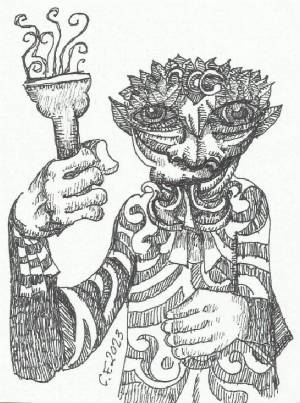|
Spring, 2024-Chris Friend

The month of April gets it's name from
the Greek
goddess Aphrodite (her Roman incarnation is Venus) in both versions were love
goddesses. April was a time of opening with the spring flowers blossoming and
opening their petals to receive the sun's life and blessing. The Anglo-Saxons
called the month Eastermonath and it is the month honoring the spring goddess
Eostee which gives her name to the Christian festival of Easter.
April 1st is April Fool's Day, a time
of the trickster
and playing pranks. Possibly the day comes from the Norse goddess Loki who was
honored on April 1st. Loki is an ornery trickster spirit who was known for
making mischief and causing trouble. This seems to also be related to the court
jesters of Medieval Europe who were the only figures who could tell a king the
truth and not suffer consequences.
Unlike other holidays like Halloween that
begin at
sunset, April Fool’s Day starts in the morning. On the Norse calendar, April
14th is the festival of Sommarsblot, or their official beginning of summer.
April 5th was the ancient Roman festival of Megalesia which was a festival of
Fortuna , better known as Lady Luck. April 10th is the final day of the
festival of Fortuna. Fortuna can be identified with Fates. April 12th was the
festival of Cerealia which was an eight-day long celebration of Ceres, an earth
goddess. She is guardian of the earth and the fruit harvest. Naturally April
would be a time of the spring planting.

April 13th was the day of the Roman festival
of
Libertas, a time to honor liberty. And as I said above February 14th was the
Norse celebration of Sommersblot, the halfway point of the year. April 22 was a
day honoring St. George who was also known as the dragonslayer. This day was a
time to see processions of revelers of dragons, hobby-horses, and giant
effigies. One of George's incarnations was Sigurd who slew a similar monster.
My own opinion was that the dragon represented
winter
with St. George who was summertime incarnate. April 25th was St. Mark’s day, in
which St. Mark was called upon to encourage the growth of the crops. It was
also known as Cuckoo's Day when the migratory birds came back home from the
south, which was a clear sign of the return of summer. April 28th was the
festival of Floralia, honoring the goddess Flora, the mother goddess of flower
and youth. Beans and other seeds were tossed into crowds celebrating the
holiday and encouraging fertility of the land. April 31st was May Eve or
Beltane Eve, a time to light great bonfires to drive away the forces of
darkness and evil. And so it goes.
Chris Friend, mars_art_13@yahoo.com, of
Parkersberg, W.Va, wrote the BP #84 poems, “The Sentinel” and “Psalm of Mithra”
(+ the BP #81 poem set, “Angel of the Bereft,” Beauty’s Sleep,” & “Dark
Trinity”; the BP #80 poem, “The Temple of Colors”; BP #79 poems, “The Marquis”
and “My Bloody Valentine”; the BP #78 poem, “The Old Yule Goat”; BP #77’s
4-poem set: “At 50,” “Owls,” “Vintage Halloween,” & “Xmas in the
Doll Asylum”; BP #76’s 4-poem set: “Hag Fairy Communion,”
“Love’s Sepulcher,” “Night Wanderer,” & “St. Andrew’s
Feast”; 2 poems for BP #75, “Angel of the Pagan Dead” and “Churchyard Watcher”;
BP #72’s 2-poem set, “Ed Gein” & “Sour Puss”; and the 2008 poem
“All Hallows’ Eve”), writes and illustrates our “MARS News” column.
He did a cover for Black Petals back in 2000 for the fall issue, and has been around ever since.
BP keeps up two websites for him and prints his column in the issue quarterly. Chris has a
gallery at http://chris.michaelherring.net/ and was featured artist in Kurt Newton’s Ultimate
PerVersities (Naked Snake) [Jan. 2011].
|

